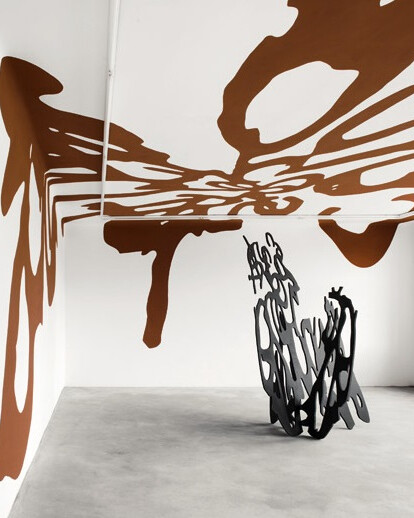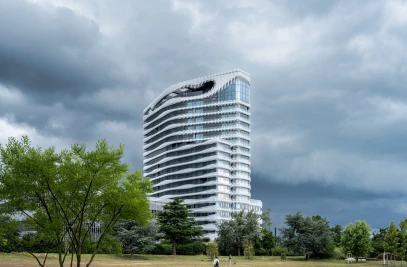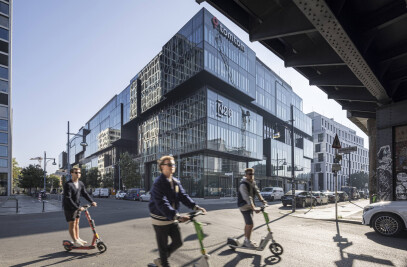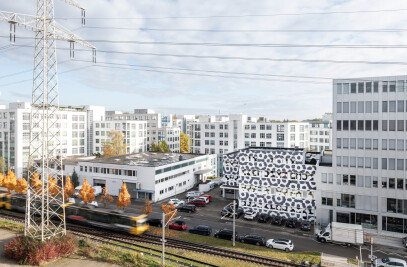Jürgen Mayer H. presents an installation with sculpture and wall paintings specially made for the EIGEN + ART Lab including a selection of drawings, collages and objects. With his team J. MAYER H. he is working on multi disciplinary space research concerning the realtion of body, natur and technology.
Lazika on the Black Sea – the exotic name sounds like the setting of a film or novel. And indeed, the city in Georgia is connected with a fiction – inasmuch as it doesn’t exist. And yet something of it can be seen. At the end of the already-built main street, on the pier of the future harbor, a snow-white structure towers like a frozen wave of spume; its waffle-like texture makes it seem delicate despite its great height. One’s initial associations are of a functionality, a futuristic lighthouse, perhaps, or a research station. But the building by Jürgen Mayer H. is free of every specific usability and is thus one thing above all: a connecting gesture between land and sea, a play with organ-like volumes, with material fixity and emptiness, with gravity and a floating condition. The “Lazika Pier Sculpture” makes it possible to experience something that it may not be able to achieve as a functional building: it shows the versatile potential of a free spatial construction and in this way bears within itself the vision of the planned city.
Constructions, whether material or conceptual, make it easier for us humans to recognize something and regard it as comprehensible. This recognizability that serves to confirm experiences and expectations allows us to call objects, spaces, or situations real. Among such constructions are the reliable parameters of the architectonic, which mirror the bearing and weight of masses, including visually, as well as surface structures or patterns on whose basis we believe we can measure, judge, and control a space. All these (rational) constructions, however, are (irrational) consoling tools to keep the great uncertainty about human existence at a distance and to give us a sense of security in the here and now. We need all kinds of constructions, because they give us hope and something to hold onto. At least we think so.
From this ambivalent perspective on constructivity, we can also view the room installation “BLACK.SEE” that Jürgen Mayer H. created specifically for the rooms of the EIGEN + ART Lab. The installation combines a black freely standing sculpture in the space with wall paintings that are likewise dark. The three-dimensional component is made out of thick panels that have been milled out in such a way that their flatness is almost completely eliminated. Its lattice-like, irregular formation seems rudimentary and incomplete. Is this a remnant of a formerly cohering construction, of a more complex whole, or possibly an enlarged detail of microstructures? Standing in direct relation to the black object in the room are the umber-colored wallpaintings. They run across walls and ceilings as mysterious patterns and seem to be an extension of the sculpture which is equally fragmentary. The paintings seem like the shadows of the sculpture, distorted by a light source that cannot be localized.
The form vocabulary to which Jürgen Mayer H. has long taken recourse, and that he employs in the installation “BLACK.SEE” as well, derives from what are called data protection patterns. These are found, for example, on the inside of envelopes sent by government agencies and banks. Their extremely dense optical pattern aims to protect the personal content of letters from indiscretion and to make sensitive data invisible by presenting a sphere of exclusive knowledge. But it is questionable whether this analog, antiquated-seeming procedure is still important today; against the background of a highly technologized, digitally shaped world, it seems more metaphorical. For there are now other, much more sophisticated ways to acquire secret data.
With his installation “BLACK.SEE”, Jürgen Mayer H. appears to allude to the deceptive promise of structures – and not just of structures that suggest the protection of personal data. In focus are structures and constructions quite generally, which lay claim to our trust in a much greater degree and convey the impression of security. When Mayer H. combines his cryptic sculpture in the room with distorted, unreal shadows, then cause and effect are rendered independent of each other, not only in the physical sense. The space thereby also expands in terms of perceptual qualities that interest one more productively than what is logical and immediately evident would – for example, the qualities of the disturbing, the lacking, the easily misunderstood, the indefinable, the risky, the unstable, or the ambiguous. In our culture, more justification to depict reality is conceded to a rational construction than to an imaginary one. But only the entirety of all sensory qualities presents the full potential of an experiential space.
Artists and those involved in the arts, whatever creative genres they may be, have always been conscious that our perception of space is always subjective, never completely calculable, and always changing. But since the 1960s in particular, architects, visual artists, choreographers, and composers have broken up and thereby expanded experiential space with consciously created empty spaces, disparate materials, fragmentary and unorthodox sequences of motion, or new patterns of sound. Donald Judd, Dan Flavin, and Fred Sandback, for example, have all been concerned with the actual, given space and equally with imaginary space. Naturally starting from purely analog spatial experiences, they purposefully questioned the validity of our standards of orientation. Often they have made use of systems of seriality and of the industrially standardized – that is, of structures that come from everyday thought and thus produce the aforementioned trust, which, however, they do not unreservedly deserve. Artists have recognized that constructions not only offer orientation, but also can definitely constrict.
With his unaccustomed form discoveries and space formations, Jürgen Mayer H., too, moves against conventional ideas, for example of architecture as something clearly defined or to be typologically categorized. Like the components of an organic system, Mayer H.’s spatial placements seem to be elements of a larger, mostly undecipherable context. They act and react congruously (but only seemingly logically) and under certain circumstances could change erratically. To the same degree as what is organic, they are highly complex, but unpredictable. In this sense, there can be no complete comprehension of a room created by Jürgen Mayer H., but nor is it absolutely necessary.
This stance has been immanent in visual art, especially since the end of Modernism, when it breaks up the dominance of everything systematic, structural, and constructive and repeatedly consciously turns to the dysfunctional, the still unfinished, the anti-constructive, or the alternatively aesthetic. In the digital world of the 21st century, in which dependence on technological systems is increasing, every error in construction, every unexpected deviation, is all the more conspicuous. In this situation, it is promising to approach the unpredictable openly and in trust. It is becoming more and more significant to continue to develop precisely those conceptual approaches that purely rational construction cannot offer. Precisely for this reason, a stance like the one Jürgen Mayer H. consistently pursues is as contemporary as it is necessary.”
Bernhart Schwenk, Chief Curator of Contemporary Art, Pinakothek der Moderne, Munich


































